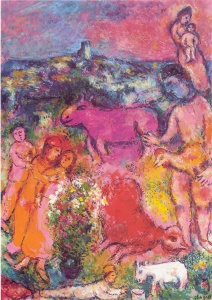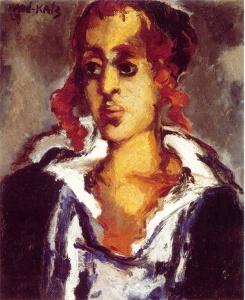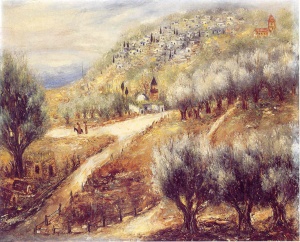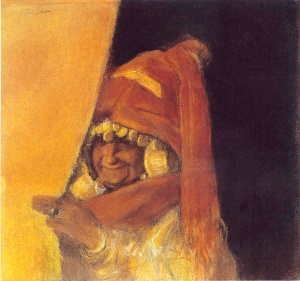Israeli Picture Book

Autour du Coq Rouge (Around the Red Rooster), painted in 1982 by a ninety-five year old Marc Chagall (1887-1985), the most famous Jewish artist of the twentieth century, puzzles us with its mysterious loveliness and grace. The Chagall bursts upon us in a passionate torrent, scintillating our visual sensibilities with pinks, hot violets and lush greens that are only partially soothed by the flickering blues of distant skies. The absurdly shaped animals in the center are guarded by three hesitant figures on the left and a gigantic figure with a rooster on the right. Behind him are a mother and child who seem to levitate above the horizon. The prone youth in the foreground feeding a little white goat serves as a horizontal balance to the unusual and evocative Provencal landscape above.
The Chagall painting is the star of the one hundred and one objects to be auctioned at Sotheby’s Tel Aviv on Sunday, April 27, 2003. This exhibition of paintings is an informative survey of Jewish and Israeli Art of the twentieth century, exploring the diversity of Israeli art works from the nineteen-twenties to the turn of the millennium.

Mane-Katz (1894-1962) represents the influence of the School of Paris on much of early twentieth century Jewish art. Paris, from 1910 until 1940, was home to many foreign born artists, including numerous Jews, and was the undisputed capital of world art. School of Paris painting was characterized by the less radical innovations of early modernism. Born in Kremenchug, Ukraine, Katz emigrated to Paris in 1921 and worked there the majority of his life. The influence of early friendships with Soutine and Chagall combined with his religious background to drive his early obsession with Jewish life in the Pale of Settlement. Many of his paintings include beggars, fiddlers, Hasidic rabbis and talmudic students. Represented here is The Student (1929), with its broad rapid brushwork typical of his expressionistic paintings that exposes the sensitive character of the disheveled yeshiva student. Throughout his life he also produced lively landscapes and still lifes, nevertheless he remained devoted to images of Jewish religious life both from the past and in contemporary Israel, frequently obtaining surprising insights by means of his unconventional, modernist and non-traditional point of view and expressive handling of paint.

Reuven Rubin (1893-1974) was also deeply influenced by the School of Paris as he attempted to forge an original Israeli national style. His work frequently celebrates local Arab and indigenous Jewish culture, emphasizing a harmonious existence with the land. There are nine works by Rubin in the auction, including flower paintings, Galilean Fishermen, a watercolor of Jacob’s Dream and a few of his signature landscapes of olive trees. Mount of Olives (ca. 1935) is a masterly example of the subject he made his own in countless works depicting the ancient olive trees with their ghostly pale leaves shimmering in the pale light as testament to their age. The road divides the composition into three sections that are echoed by the three trees in the foreground. The trio is again seen in the three kinds of buildings depicted, an Eastern Church, a red tiled Italianate Church and the little Arab village clustered on the hill above. Rubin’s deep and abiding commitment to Eretz Israel is conveyed by the compositional balance and weight of this timeworn landscape.
The auction, billed as “International and Israeli Art”, is dominated by all of the serious Israeli artists of the last century. The early Bezalel School of Art (1906-1920), founded by Boris Schatz, is represented by Abel Pann in a folklorist approach to a Jewish subject. Soon its students rebelled and sought to integrate new and modern styles of Fauve art, naïve art and the Expressionism of the School of Paris into the content of contemporary Palestinian society seen in works by Rubin, Nahum Gutman and Israel Paldi. By the1950’s the influence of the New York School abstract painting dominated in the “New Horizons” group lead by Joseph Zaritzky, Yehezkiel Streichman and Avigdor Steimatsky, all represented here, albeit by relatively minor works. A later generation of abstract and late modern artists is represented by Leah Nikel, Arieh Aroch, Raffi Lavie, Michael Gross, Ori Reisman, Moshe Kupferman and Avigdor Arikha. Many of these artists are still painting and are subjects of important retrospectives in Israel today.

The work of Abel Pann (1883-1963) is represented by And Sara heard it in the tent door, clearly a reflection of his 1930 The Bible in Pictures. His use of local Arab models and dress to imagine the biblical narrative were widely popular in mass reproductions in Israel for many years. He studied in Paris with Adolphe William Bouguereau, the consummate sentimental academic painter the Impressionists rebelled against, and Toulouse-Lautrec, the master of modernist unconventional poster design. These wildly disparate teachers combined to establish his formable skills as a painter, pastel artist and illustrator. While many of his works are superficial illustrations of the biblical text, this pastel is exceptional because of the dramatically stark design of the tent door and Sara’s bizarre costume. Even though the exotic costume ultimately distances us from the narrative, the strong composition draws us into the intriguing mindset of our ancient matriarch as depicted here. Perhaps this grinning old lady is a reflection of the tribal folk wisdom that was accustomed to challenging God Himself. Works like this establish Pann as an early biblical artist to be reckoned with.
From the exotic view of Abel Pann to the nonagenarian Marc Chagall’s fantasy this auction charts a selective course of Jewish art in the twentieth century. The majority of works here take their cue from what Katherine Kuh, art critic and former curator at The Art Institute of Chicago, said about Chagall; “But it is best to accept Chagall’s work without laborious probings. He tells us that his painting are to be looked at – not interpreted.” While this is quite true of many works of art, it is simultaneously their strength and tragic flaw.
International and Israeli Art, April 27, 2003
Sotheby’s Tel Aviv
46 Rothschild Blvd. Tel Aviv, Israel
www.sothebys.com